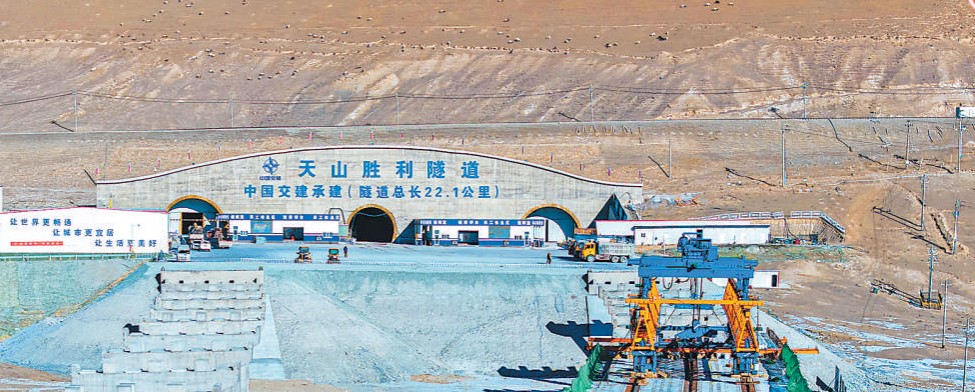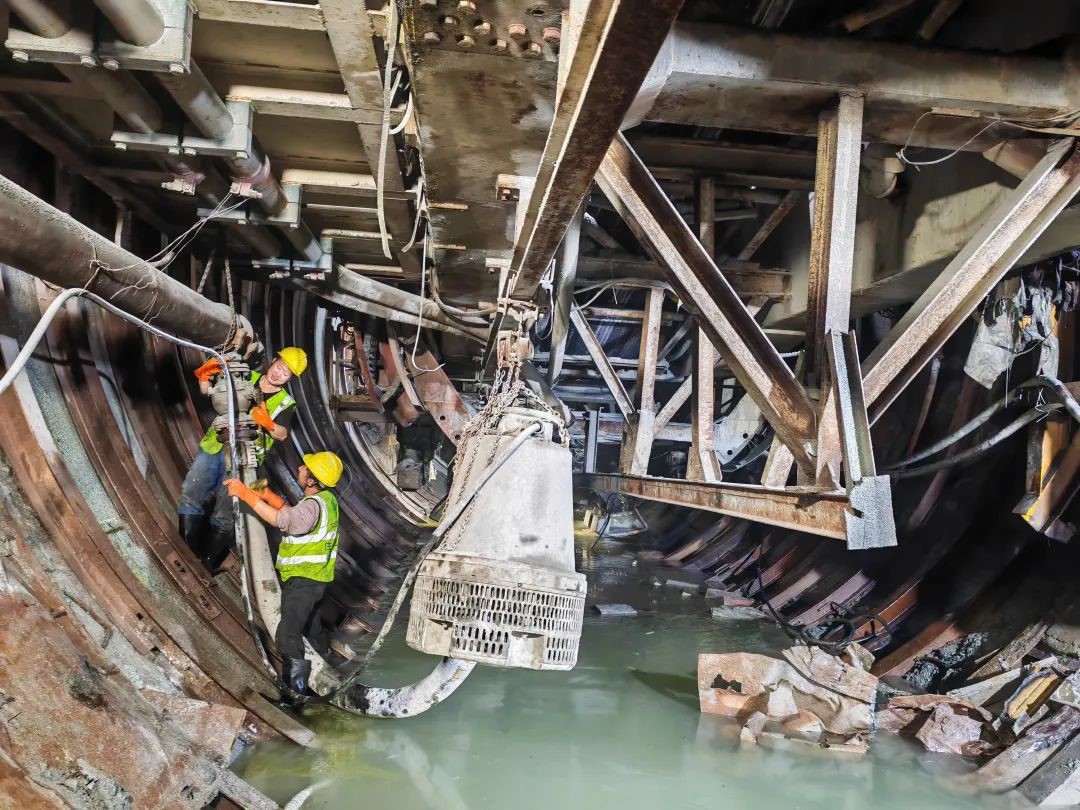World's longest expressway tunnel completed in NW China's Xinjiang
The Tianshan Shengli Tunnel, the world's longest expressway tunnel located in northwest China's Xinjiang Uygur autonomous region, completed tunneling on Dec. 30, 2024.
Built by China Communications Construction Company Limited (CCCC), the 22.13-kilometer tunnel will reduce the time it takes to drive across the middle section of the Tianshan Mountains from several hours to about 20 minutes once operational.
It is a key project of the Urumqi-Yuli Expressway, which runs from the regional capital of Urumqi in northern Xinjiang to Yuli county in southern Xinjiang.

Photo shows the southern exit of the Tianshan Shengli Tunnel, northwest China's Xinjiang Uygur autonomous region. (People's Daily/Zhang Wujun)
Since construction began in 2020, thousands of builders have worked in the mountains. Over the course of 52 months, the construction team overcame challenges such as complex geological conditions, high altitudes, extreme cold, and high ground stress, achieving another groundbreaking feat in China's expressway tunnel construction.
Notably, this project was the first in the country to use a hard rock tunnel boring machine (TBM) for expressway construction and pioneered an innovative construction method for rapid excavation, significantly shortening the construction period.
How to pass through the fault zones?
According to Huang Dengxia, chief engineer of the fifth section of the Urumqi-Yuli Expressway project under CCCC, the tunnel passes through 16 geological fault zones, 12 of which are located at the tunnel's entrance, featuring fragile and complex rock formations. Besides, the tunnel's construction faces high ground stress, with peak stress reaching nearly 22 MPa, said Huang.
"It's just like working in a 'tofu pudding' environment with a high risk of mud surges and rock bursts," Huang remarked.
At 1,900 meters into the entrance, the construction team encountered F6, the largest fault zone along the route that spans 440 meters in width. Its fractured, water-rich rock posed immense difficulties for construction.
"Hard rock TBMs are especially vulnerable to the environment where the rock alternates between hard and soft layers," said Wu Teligen, head of the engineering department of the fifth section. "Collapses and water inflows often occur in such conditions. Sometimes, water inflows could reach as much as 7,000 cubic meters in a single day."
To address the persistent threat of collapses, the team anchored over 37,800 polyethylene pipe foam concrete components into the rock face, creating a shock-absorbing layer that is 70 centimeters thick, which helps mitigate the fault zone's stress impact on the surrounding rock supports. After 80 arduous days, the team successfully navigated through the fault zone F6.
How to shorten construction period?
With traditional drilling and blasting methods, it would take 72 months to cut two 22.13-kilometer-long holes through the Tianshan Mountains. However, to foster regional development and address local people's transportation needs, it is important to shorten the construction time.

Builders work at the entrance of the Tianshan Shengli Tunnel, northwest China's Xinjiang Uygur autonomous region. (Photo/Lu Fengbao)
"After extensive research and analysis, we broke down the construction into smaller, more manageable segments, allowing for faster excavation," said Miao Baodong, chief engineer of the Urumqi-Yuli Expressway project.
To be specific, the team added a middle drift between the two parallel main tunnels, with hard rock TBMs, customized by CCCC for the Tianshan Shengli Tunnel, acting as "trailblazers," Miao said, adding that this approach effectively segmented the main tunnels into multiple sections for simultaneous excavation.
At the construction site, the two TBMs, named "Tianshan" and "Shengli," advanced respectively from the northern and southern sides of the Tianshan Mountains, with the massive cutterheads driving dozens of blades forward to crush rock into fragments. The machines proceeded at a speed of 20 to 30 meters per day, which was over five times faster than manual drilling, thereby reducing the original construction time to 52 months.
How to ensure construction safety and efficiency?
The innovative construction method has significantly increased the excavation speed and provided additional working faces. However, it also presented new challenges - how to ensure construction safety and efficiency at the same time.
"During peak construction, the exit end of the tunnel alone had seven working faces operating simultaneously, with over 1,200 personnel and 600-700 vehicles passing through every day," said Li Yalong, manager of the sixth section of the Urumqi-Yuli Expressway project.
"To ensure safe and orderly operations, we created an intelligent system to coordinate transportation within the tunnel, equipped vehicles with positioning devices, and adopted electronic access control for personnel. Technology has been a vital tool in our construction," Li added. For instance, a digital monitoring and command center has been established, providing real-time data on the movement of personnel and vehicles within the tunnel in a single interface.
The project also set up a specialized technical team to ensure that the two TBMs running from the opposite sides met precisely within the mountain. Every six months, the team conducted joint measurements from both the entrance and exit ends of the tunnel to carefully calibrate the plane control points and elevation control network so as to keep the tunnel alignment on track.
Photos
Related Stories
- In pics: Swan Spring Wetland Park in Yining County, China's Xinjiang
- Tarim Oilfield supplies record high volumes of natural gas to southern Xinjiang
- Torugart Port in Xinjiang handles 150,000 passengers in 2024
- Rime frost blankets Habahe Birches Park in NW China's Xinjiang
- Northwest China’s Xinjiang sees record high passenger crossings and freight transport at its ports in 2024
Copyright © 2025 People's Daily Online. All Rights Reserved.









